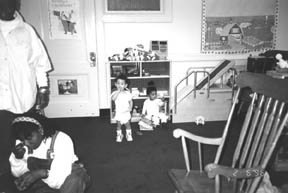|
No
Longer In Their Infancy: Centers
Provide The Best of Education
By
Tom Kertes
Infancy
centers are becoming an increasingly sizable slice of American
life. “It’s one thing to say that, in an ideal world, mothers
should stay at home and raise their babies,” said Nancy Wiener,
Educational Director of Upper Manhattan’s The House of Little
People (HLP). “But the reality is that most families these days
need two incomes to survive. So, for many mothers, staying at
home is not an option any longer.”
President Lyndon Johnson, whose Operation Head Start provided
the first federal funds for the “day care and education of infants
and toddlers”, recognized this as far as 40 years back. Still,
societal resistance has been so strong that infancy centers have
only come into real vogue over the past eight to ten years. “Even
today, there are still less than 500 such places in the New York
Metropolitan area,” said Barbara Robinson, the Founding Director
of HLP.
“I
may be biased, but I’m convinced that a school like ours is actually
better for an infant than being raised at home,” said Wiener.
“Every single minute of every single day, there’s education going
on here.”
A somewhat different center exists at the Rita Gold Early Childhood
Center. “Being affiliated with Columbia University and Teachers
College, we serve several different functions,” said Faculty Director
Dr. Susan L. Recchia. “Besides providing day care and education,
we conduct a lot of research – we are studying ourselves, if you
will – and run a strong outreach program as well.”
Both centers take the approach that “an infancy center is much
more than just a place where children come to play day after day.”
“We are preparing the children to be successful in school – and
to be successes in life,” said Dr. Recchia. Yet Rita Gold, which
particularly prides itself on providing inclusive and culturally
respectful care for infants, takes strong cultural cues from each
individual parent, even to the point of feeding each child daily
at his or her own preferred time. “That we’d never do,” said HLP’s
Wiener. “Here, the children all eat together. That’s a large part
of our goal of building a community.”
Community-building is the goal at Rita Gold as well. “One of the
things that makes a center like this special is that the children
have a chance to interact with each other – and with adults as
well,” Dr. Recchia said. “We’re learning that even very young
babies develop friendships. And that a chance at such early attachments
makes them more advanced and socially comfortable for the future.”
At both centers, each infant pretty much has his or her very own
caretaker – as well as an avalanche of vigilance from every educator
in the room. “No question, at this early age, individual attention
is a must,” Dr. Recchia said.
Rita Gold, more experimental due to its academic aspect, allows
parents to stay for as a long as a week at the beginning of the
child’s stay: “We take our cues from them”, said Dr. Recchia.
HLP subscribes to the philosophy of building a child’s cognitive
skills by “respecting the senses”. “At this very early age – our
infants vary from the age of three months to two and a half years
– every day is a transition period,” Wiener said. “A child can
literally return after a weekend as quite a different little person
than he was the previous Friday.”
Both centers follow the “total child” concept, dealing with their
miniature clients’ development from a physical, psychological,
social, and emotional point of view. “Learning about the
importance of caring about others is paramount with us,” Robinson
said. “You can’t have an emotionally healthy and socially successful
child without that sense.”
As an educational institution, Rita Gold often uses graduate students
as teachers. HLP employs strictly professionals. Rita Gold provides
bilingual education whenever possible. HLP, while acknowledging
cultural differences, concentrates on teaching the children in
English. Rita Gold, limited to Columbia University students and
faculty, costs only $75 a semester. HLP, a private school open
to the general public, costs $975 a month.
Yet, in spite of – or perhaps because of – their differences,
these are both schools of the very highest quality. “We take the
very best of all educational theories, listen to what the children
are ‘teaching us’, then mix in our own 25 years of experience,”
Robinson said. “Children at this age are literally capable of
absorbing anything. What we try to provide them is non-stop
enhancement, socially, educationally, and emotionally.”

Education Update, Inc., P.O. Box 20005, New York, NY 10001. Tel:
(212) 481-5519. Fax: (212) 481-3919. Email: ednews1@aol.com.
All material is copyrighted and may not be printed without express consent of
the publisher. © 2001.
|

